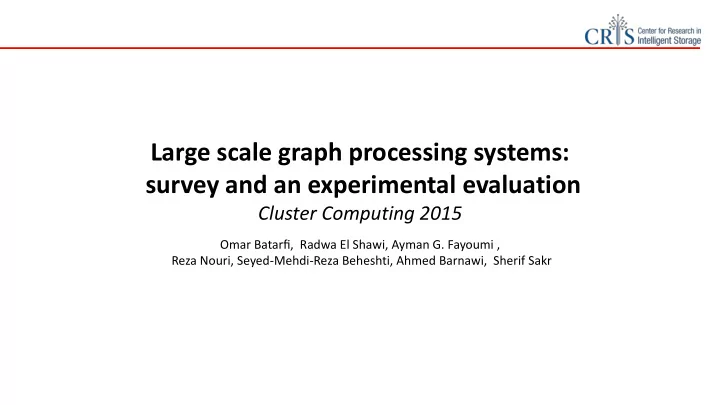

Large scale graph processing systems: survey and an experimental evaluation Cluster Computing 2015 Omar Batarfi , Radwa El Shawi, Ayman G. Fayoumi , Reza Nouri, Seyed-Mehdi-Reza Beheshti, Ahmed Barnawi, Sherif Sakr
Graph scale Scale: millions to billions of nodes and edges Facebook social network graph: 1 billion+ users (nodes) 140 billion+ friendship relationships (edges) The size of a single node/edge can be very different due to the various attributes size or nodes/edges An Estimation of large-scale graph size: 1 GB to 500 TB ~0.5 GB/million nodes, ~0.20 GB/million edges 1 million nodes/edges: ~0.5 GB nodes & ~0.20 GB edges 500 billion nodes/edges: ~250 TB nodes & ~100 TB edges GB/million nodes GB/million edges 0.42 0.20 0.84 0.13 11.39 2.60 1.83 0.07 0.58 0.23 0.48 0.19 0.44 0.18
platforms General-purpose platforms (such as MapReduce) are bad No direct support for iterative graph algorithms To detect a fix point (termination condition), an extra task might be required on each iteration Specialized platforms Pregel family Graphlab family Others
Algorithms Characteristics of graph algorithms Iterative Need to traverse the graph Typical graph algorithms PageRank : rank nodes based on their incoming/outgoing edges Shortest Path : find the path between 2 nodes where the sum of weights is minimal Pattern Matching : find certain structures (e.g. path, star) Triangle Count : counts the number of triangles Connected Component : find the subgraphs in which any two vertices are connected
Pregel family Pregel: Google’s pioneer work in this area Published in 2010 Distributed & computations are totally in memory Iteration -> superstep Address scalability issue Bulk Synchronous Parallel (BSP ): synchronization barrier on each superstep Message passing interface (MPI) Vertex-centric approach Locality : Each vertex & its neighbors are in the same node A vertex can: execute a function/send messages to others/change states (active/inactive) Termination: no active vertices & no messages being transmitted Pregel family Apache Giraph: Java implementation of pregel GPS: another Java implementation Pregelix: set- oriented, iterative dataflow
GraphLab family GraphLab Shared memory GAS (Gather, Apply, Scatter) processing model Gather: a vertex collects info of its neighbors Apply: performs computation Scatter: update adjacent vertices and edges Comparison GAS : pull-based; a vertex request info of all neighbors MPI: push-base; a vertex receives info from neighbors Two modes: Synchronous model (BSP): communication barriers Asynchronous model: using distributed locking; no communication barriers orsuperstep GraphLab family PowerGraph: avoid the imbalanced workload caused by high degree vertices in power-law graphs Trinity: memory-based; distributed Signal/Collect: vertex-centric; two operations for a vertex (signal/collect) Graphchi
GraphLab family cont’d Graphchi : Out-of-core: using secondary storage in a single machine Parallel Sliding Window (PSW): Goal: decreases non-sequential accesses on disk It partitions the graph into shards In each shard, edges are sorted by the source IDs Selective scheduling: Converge faster on some parts of the graph “some parts” - > the change on values is significant Pros It avoids the challenge of finding efficient graph cuts Now with zone-based devices, partitioning is needed again It avoids cluster management, fault tolerance etc. Out-of-Core + SMR
Other systems TurboGraph Out-of-core Processing billion-scale graphs using modern hardware -> parallelism Multicore CPU: multiple job at the same time FlashSSD : multiple I/O requests in parallel using multiple flash memory packages A parallel model called pin-and-slide : column view of the matrix-vector multiplication Two types of thread pools Execution thread pool Asynchronous I/O callback thread pool Steps Restrict computation to a set of vertice -> identify the corresponding pages -> pin those pages in the buffer pool -> processing completes for a page -> swtich unpinned -> can be evicted now -> Parallel asynchronous I/O request to the FlashSSD for pages which are not in the buffer pool The system can slide the processing window one page at a time Multiple channel SSD Extreme-large-scale graph that does fit into memory CMR -> SMR/Zone named SSD
Other systems GRACE Out-of-core Batch-style graph programming frameworks Providing a high level representation for graph data Separating application logic from execution policies. Combine synchronous programming with asynchronous execution
Experiments Perforamance metrics Reading Time , Processing Time, Writing Time, Total Execution Time, CPU Utilization, RAM Usage, Network Traffic Deployed on Amazon AWS cloud services The execution times metrics for the PrageRank algorithm for all systems using the different datasets
Recommend
More recommend